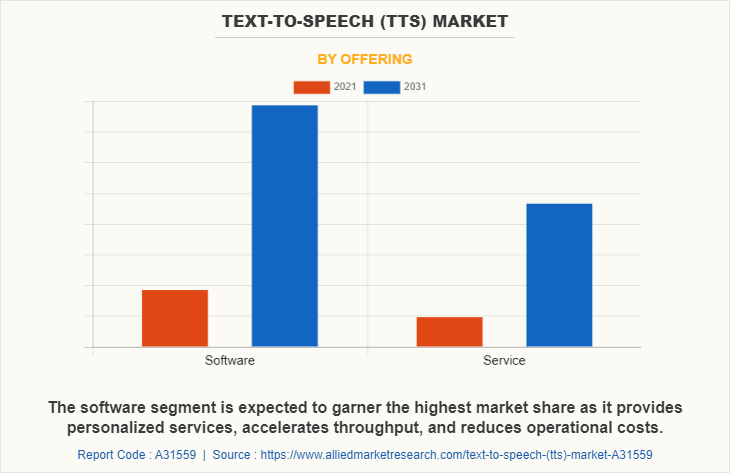Text-to-Speech (TTS) Market Insights, 2031
The global text-to-speech (tts) market was valued at USD 2.8 billion in 2021, and is projected to reach USD 12.5 billion by 2031, growing at a CAGR of 16.3% from 2022 to 2031.
Rising preference for handheld devices and the increasing number of people suffering from visual impairments and learning disabilities propels growth of the global text-to-speech market. In addition, rising adoption of voice assistants & smart speakers to aid growth fuel growth of the text-to-speech market. However, privacy issues to impede adoption of voice-enabled application and complexity in generating prosody and pronunciation of naturally occurring speech is expected to impede the text-to-speech market growth. Furthermore, increase in use of digital transformation technology is expected to provide lucrative opportunities for the text-to-speech market during the forecast period.

Text-to-speech systems, also known as TTS is developed to aid the visually impaired by offering a computer-generated spoken voice that would read text to the user. In addition, TTS can help people who struggle with reading. The TTS Market is segmented into Industry Vertical, Offering, Deployment Model, Type, Lanuage and Enterprise Size.
Segment Review
The TTS Market is segmented on the basis of by offering, deployment mode, type, language, enterprise size, industry vertical, and region. On the basis of offering, the market is categorized into software and service. On the basis of deployment mode, the market is fragmented into on-premise and cloud. On the basis of type, the market is classified into neural, non-neural. On the basis of language, the market is divided into English, Chinese, Spanish, Hindi, Arabic, and others. On the basis of enterprise size, the market is bifurcated into large enterprises and SMEs. By industry vertical, it is classified into BFSI, travel and tourism, it and telecom, education, retail and consumer goods, automotive and transportation, media and entertainment, and others. By region, the market is analyzed across North America, Europe, Asia-Pacific, and LAMEA.
Major players operating in the text-to-speech market include Acapela Group, Amazon.Com, CereProc, Google, Inc., IBM Corporation, iFlytek, iSpeech, LumenVox LLC, Microsoft Corporation, NextUp Technologies, Nuance Communications, Readspeaker, Sestek, Sensory, Inc., TextSpeak, Deepdub, Neosapience. These players have adopted various strategies to increase their market penetration and strengthen their position in the industry.

In terms of offering, the software segment holds the highest text-to-speech market share as it provides personalized services, accelerates throughput, and reduces operational costs. However, the service segment is expected to grow at the highest rate during the forecast period. These services reduce managing concerns efficiently with personalized assistance and optimized performance development.
By Region
The demand for Text-to-Speech is growing in the North America owing to, rise in adoption of text-to-speech in academic, political, and corporate sectors.
Region wise, the text-to-speech market size was dominated by North America in 2021, and is expected to retain its position during the forecast period, owing to rise in adoption of text-to-speech in academic, political, and corporate sectors. However, Asia-Pacific is expected to witness significant growth during the forecast period, owing to rise text-to-speech technology investment.
Top Impacting Factors
Rising preference for handheld devices
The number of handheld devices is increasing across the globe, owing to the growing demand for automation and convenience which is driving the growth of the market. Moreover, mobile devices, smartphones, portable devices, digital assistants, and other handheld devices use text-to-speech software to eliminate the need for users to read lengthy user guides or manuals by providing verbal prompts and audio directions for operations.
Furthermore, mobile devices have transformed from voice-calling devices to more advanced personal computing devices that allow users to perform activities such as browsing the internet, capturing photographs, language translation, navigation guidance, and managing entertainment and multimedia content. Many such advancements in smart devices are expected to increase the integration of text-to-speech technology into handheld devices. Such demands are driving the growth of the text-to-speech industry.
The increasing number of people suffering from visual impairments and learning disabilities
Text-to-speech technology can assist people with visual impairments and learning disabilities in a variety of ways. The industry is expected to see new opportunities for development as well as new types of advanced technologies. In addition, in recent years, it’s branched out into an international market, creating new opportunities to use strategies that have already run their course globally. Moreover, people with reading disabilities have a difficult time deciphering text, so text-to-speech technology can help such people by converting their texts into an auditory format and making them easier to understand.
For instance, according to the National Library of Medicine, in 2020 an estimated 2.2 billion people are visually impaired worldwide, which provides an opportunity for market growth. Furthermore, text comprehension and content comprehension are difficult for people with learning disabilities. As a result, their development and knowledge processing skills suffer, so text-to-speech technology assists such people, which in turn is driving the growth of the text-to-speech market trends.
COVID-19 Impact Analysis
The text-to-speech industry has witnessed stable growth during the COVID-19 pandemic, owing to a rise in technology with schools and universities going online during the pandemic situation. In addition, the COVID-19 pandemic has resulted in the deployment of technology across various academic institutions for online classes and learning, which, in turn, has driven the development of advanced machine learning models.
In addition, with rapid digital transformation, various governmental funding for education for differently-abled students is anticipated for market growth. Thus, speech-to-text technology helps in communicating with the users when the text on the screen is not clear or reading the text becomes inconvenient. However, technological advancements result in the development of enhanced features in speech-to-text technologies to adopt AI/ML technologies, owing to long development timelines and high investment requirements.
Key Benefits for Stakeholders
- This report provides a quantitative analysis of the Text-to-Speech Market Forecast, current trends, estimations, and dynamics of the text-to-speech (tts) market analysis from 2021 to 2031 to identify the prevailing text-to-speech (tts) market opportunities.
- The market research is offered along with information related to key drivers, restraints, and opportunities.
- Porter's five forces analysis highlights the potency of buyers and suppliers to enable stakeholders make profit-oriented business decisions and strengthen their supplier-buyer network.
- In-depth of the Text-to-Speech Market Analysis assists to determine the prevailing market opportunities.
- Major countries in each region are mapped according to their revenue contribution to the global market.
- Market player positioning facilitates benchmarking and provides a clear understanding of the present position of the market players.
- The report includes the analysis of the regional as well as global text-to-speech (tts) market trends, key players, market segments, application areas, and market growth strategies.
Text-to-Speech (TTS) Market Report Highlights
| Aspects | Details |
| Market Size By 2031 | USD 12.5 billion |
| Growth Rate | CAGR of 16.3% |
| Forecast period | 2021 - 2031 |
| Report Pages | 345 |
| By Industry Vertical |
|
| By Offering |
|
| By Deployment Model |
|
| By Type |
|
| By Lanuage |
|
| By Enterprise Size |
|
| By Region |
|
| Key Market Players | LumenVox LLC, Sestek, iFlytek, IBM Corporation, Readspeaker, Nuance Communication, Deepdub, NextUp Technologies, Amazon.Com, Acapela Group, Google, Inc., iSpeech, TextSpeak, Sensory, Inc., GL Communications, Microsoft Corporation, CereProc, Neosapience |
Analyst Review
Text-to-speech is a technology that enables text to be converted into speech sounds imitative of the human voice. In addition, it is a natural language modeling process that requires changing units of text into units of speech for audio presentation. This is the opposite of speech to text, where a technology takes in spoken words and tries to accurately record them as text. Moreover, it allows users to see text and hear it read aloud simultaneously. There are many apps available, but typically as text appears on the screen, it’s spoken. Some software uses a computer-generated voice and others use a recorded human voice. Very often the user has a choice of gender and accent as well.
The global text-to-speech market is expected to register high growth due to increasing penetration of Internet-enabled handheld smart devices. Increasing globalization and global tourism and trade is another factor are expected to drive industry growth. Thus, increase in adoption of text-to-speech, owing to its security is one of the most significant factors driving the growth of the market. With surge in demand for text-to-speech, various companies have established alliances to increase their capabilities. For instance, in June 2022, Fluent.ai partnered with Knowles Partner to deliver fully offline, noise robust and multilingual/multi-accent voice control for washing machines and other home appliances.
In addition, with further growth in investment across the world and the rise in demand for text-to-speech, various companies have expanded their current product portfolio with increased diversification among customers. For instance, in June 2022, Mycroft AI launched latest text-to-speech (TTS) engine, Mimic 3. This open-source neural TTS software is designed to provide the most natural sounding voice to date It can run completely offline on low-end systems.
Moreover, with increase in competition, major market players have started acquisition companies to expand their market penetration and reach. For instance, in June 2022, Spotify acquired Sonantic which has developed text-to-speech technology capable of generating (in its words) “compelling, lifelike performances with fully expressive AI-generated voice.
The global text-to-speech market was valued at $2.79 billion in 2021, and is projected to reach $12.53 billion by 2031
The text-to-speech market is projected to grow at a compound annual growth rate of 16.3% from 2022 to 2031.
Major players operating in the text-to-speech market include Acapela Group, Amazon.Com, CereProc, Google, Inc., IBM Corporation, iFlytek, iSpeech, LumenVox LLC, Microsoft Corporation, NextUp Technologies, Nuance Communications, Readspeaker, Sestek, Sensory, Inc., TextSpeak, Deepdub, Neosapience. These players have adopted various strategies to increase their market penetration and strengthen their position in the industry.
Region wise, the text-to-speech market size was dominated by North America in 2021 and is expected to retain its position during the forecast period.
Rising preference for handheld devices and the increasing number of people suffering from visual impairments and learning disabilities propels growth of the global text-to-speech market. In addition, rising adoption of voice assistants & smart speakers to aid growth fuel growth of the text-to-speech market.
Loading Table Of Content...


